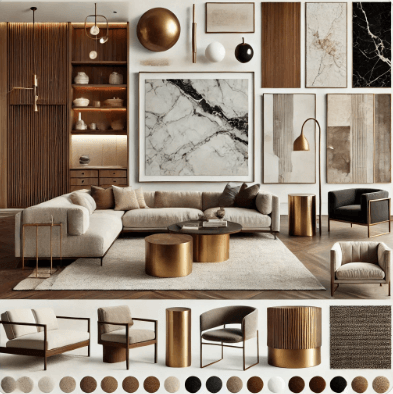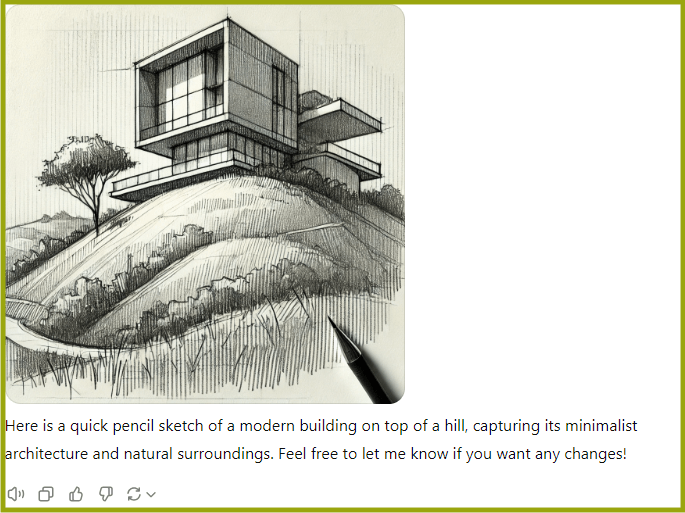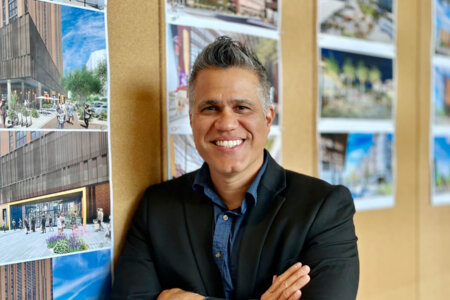AI and Design: Through the Looking Glass

RSP’s Victor Irizarry addresses the pros, cons and implications of the evolving relationship between AI and design.
*Pictured: Left: Hand-drawn sketch, created in 15 minutes. Right: Chat GPT 4o rendering based on Victor’s sketch with new concept, created in one minute.
“Imagination is the only weapon in the war against reality.”― Lewis Carroll
The intersection of artificial intelligence (AI), architecture and design has opened up exciting new possibilities in design and execution that, to be honest, feel almost surreal. As AI-powered tools become increasingly prevalent in the industry, more architects, designers and artists are raising questions about efficiency, ethics and legalities. Architectural design needs to delve into the positive and negative aspects of using AI as a design tool. We must look toward providing a balanced perspective for professionals navigating this evolving landscape. After all, AI is here to stay.
Speed Meets Skill: The Efficiency of AI
Efficiency of Time
One of the most significant advantages of AI-powered tools is the substantial increase in efficiency when performing repetitive tasks. Traditional design processes can be time-consuming, often requiring several iterations to refine ideas. A good and efficient AI platform could help streamline this by quickly generating multiple design concepts based on input parameters. This acceleration allows designers to spend more time on other critical aspects of their projects, such as client interaction, site visits, and refining the final design.
Accessibility
AI drawing tools democratize the design process, making it accessible to designers with varying levels of drawing skills. For those who may not feel confident in their freehand drawing abilities, AI offers a platform to translate their ideas into visual formats without the need for advanced artistic techniques. However, this accessibility must be managed carefully to avoid over-reliance and ensure the development of essential traditional drawing skills. Understanding foundational drawing and drafting skills will always be crucial to becoming a good architect. But these new tools can broaden the field and bring new voices and perspectives to the table that might otherwise find perfected drawing skills a barrier to entry for the profession.
Exploration
AI enhances the exploration phase of design by generating a diverse array of design options from a set of input parameters. This capability allows designers to explore a wider range of possibilities, pushing creative boundaries and innovating beyond conventional solutions. For instance, using AI to create “design mood boards” can help designers visualize different material combinations and aesthetic themes in a rough layout, allowing different ideas to marinate. Designers can then use their own expertise to tailor the concepts to the challenge at hand.

The Human Touch: Challenges of AI in Design
Dependency
A significant concern with the increasing use of AI in architecture is the potential for dependency. Over-reliance on AI tools might lead to a decline in traditional drawing skills and craftsmanship. This dependency could limit a designer’s ability to freely express ideas through hand-drawn sketches, which remain a vital part of the creative process.
Lack of Personal Touch
AI-generated drawings, while efficient, lack the unique touch and style that come with hand-drawn sketches. The personal nuances in an architect’s hand-drawn work often carry an emotional connection and a sense of individuality that can resonate deeply with clients. Losing this personal touch could diminish the relationship between the designer, the client, and the final product.

Limited Creativity
While AI tools offer a plethora of design options, there is a risk of creativity being stifled by the constraints of algorithms and templates. Designers might find themselves limited to the predefined possibilities generated by AI, potentially hindering the organic flow of creative ideas and unique solutions that arise from traditional sketching.
Ethical Considerations
The integration of AI in architecture also raises ethical questions regarding ownership and authorship of designs. As AI tools generate design concepts, it becomes challenging to attribute creativity and originality solely to the designer. Additionally, there are concerns about the impact of AI on employment opportunities for traditional designers and artists, who may find their roles diminished in an AI-dominated environment.

Technical Issues
Finally, like any technology, AI drawing tools are not immune to technical glitches and limitations. These issues can disrupt the design process, causing frustration and inefficiency. Designers must be prepared to troubleshoot and adapt when encountering such challenges, ensuring that AI remains a tool that enhances rather than hinders their work.
Breaking Boundaries: AI’s Role in Creative Exploration
AI as a design tool for architects offers a blend of remarkable advantages and noteworthy challenges. Its ability to enhance efficiency, accessibility, and exploration in design is counterbalanced by concerns about dependency, loss of personal touch, limited creativity, ethical implications, and technical issues.
As designers, it is crucial to strike a balance, leveraging AI’s capabilities while maintaining the traditional skills and creative freedom that define the essence of our profession. By doing so, we can harness the power of AI, thinking of it as another tool in our tool belts to elevate our work without compromising the artistry and personal connection that are the foundation of architecture’s impact.
Overcoming the Fear of Change
The fear of change has long been a companion to technological progress in the design world. I vividly recall my own transition from handmade ink drawings to Computer-Aided Design (CAD) programs. Many feared that this shift would mark the end of creativity in architecture. Much like today’s concerns about AI, the introduction of CAD was seen as a threat to the artistry and personal touch that defined our craft. Yet, as I adapted to this new tool, I realized that technology didn’t kill creativity—it transformed it. It opened doors to new forms of expression and efficiency without erasing the need for human insight.
Victor Hugo’s famous words in The Hunchback of Notre Dame, “This will kill that. The book will kill the edifice,” echo this tension. While the printing press expanded humanity’s ability to create through the written word, it also seemed to diminish our reliance on architecture as a medium of expression. And yet, great architecture and design remain as a testament to human ingenuity, culture and imagination. Similarly, AI offers incredible advancements for the design process. But it’s essential to remember that it is a tool, not a replacement. Just as CAD revolutionized the way we work without killing creativity, AI has the potential to do the same. If we approach it with balance and embrace its benefits while safeguarding the irreplaceable human touch that remains at the heart of design.




